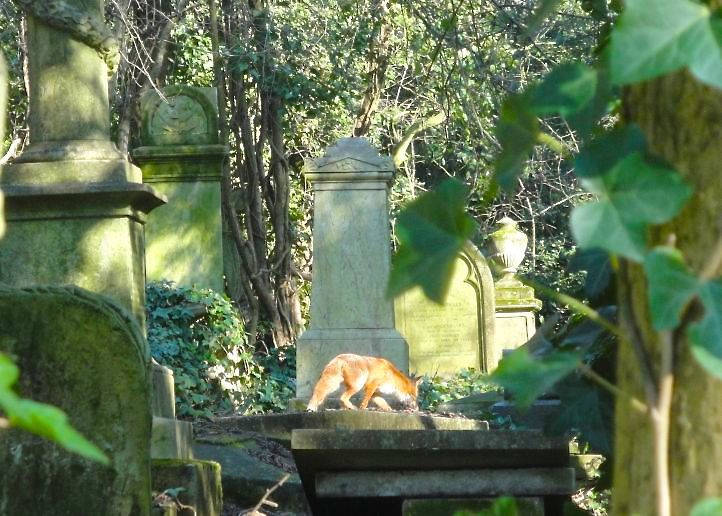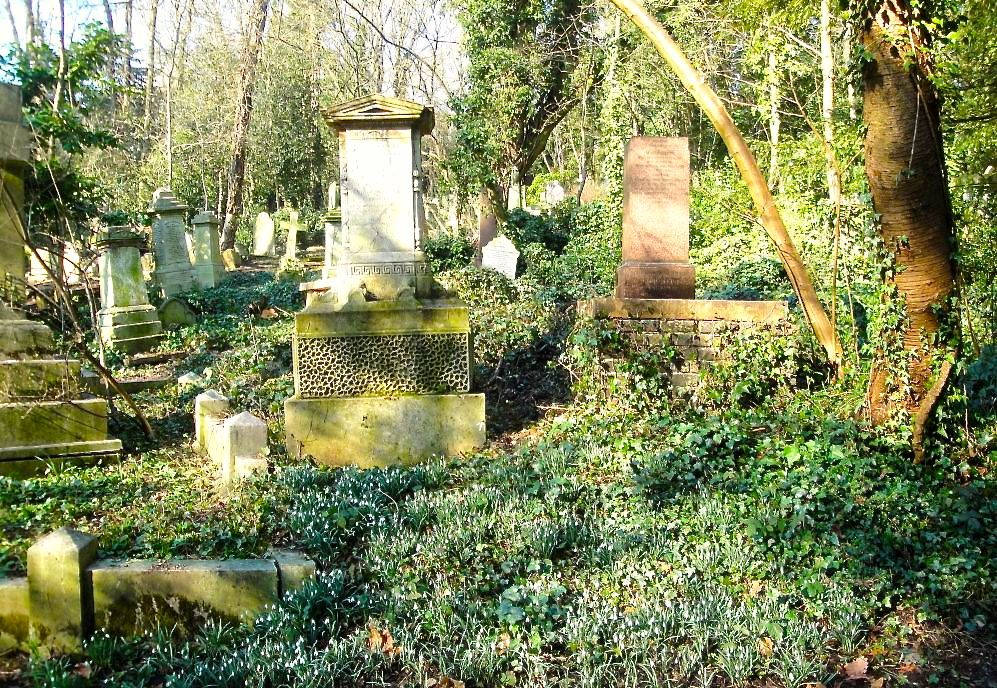Photographs by Robert Freidus, reproduced here by kind permission of Highgate Cemetery. Captions, commentary and formatting by Jacqueline Banerjee. [Click on the images for larger pictures. See the index for the cemetery for many more views of the cemetery and its monuments.]
Winding Paths



Left to right (a) A variety of memorials, including s draped urn, a pink granite obelisk and several crosses, on a path winding to the left. (b) A path winding to the right, with some chest-tombs and a sprinkling of snowdrops on the verge. (c) Another path curving to the right
The last picture on the right shows a broken column twined with carved ivy — a typical monument showing life cut short but its memory clung to steadfastly, and a dignified neo-classical Portland stone mausoleum. The Grade II listed mausoleum is that of Mrs Emma Guerrier, who died in 1872. While the Circle of Lebanon is dramatic and atmospheric, the rest of the cemetery reveals itself more gradually. It is "one of the great cemeteries of the world (to those who know it, one of the Wonders)," writes Felix Barker, adding, "but in many ways it is also one of the most secret. A maze of winding paths, tombs and catacombs, it is a monument to the Victorian age and to the Victorian attitude to death" (1) — mysterious in its solemnity, and shrouded finally in the larger power of nature.
A Terraced Hillside



Left to right (a) A neat corner leading to a level path on the terraced hillside. (b) A row of graves, mostlyly chest-tombs, one with the addition of smart railings, and a crosses, one built up on a cairn of artistically piled stones. (c) A row of pedestals crowned with draped urns, going downhill again.
An early guidebook commented on the way the land here rises in terraces, the paths "leading through long avenues of cool shrubbery and marble monument, and the groups of majestic trees casting broad shadows below" (Justyne 7). The view from the terrace at the top of the cemetery would have been amazing in the early years, over the fields and orchards below and right across the Thames Valley towards Surrey and Kent (see Barker 1). People came from far and wide to promenade here and enjoy the sight.
A Nature Reserve



Left two: Foxes make themselves at home here, as in other cemeteries all over London. Right: A carpet of snowdrops around the monuments.
Like other cemeteries, this one has become an important natural habitat, the more so now that the surroundings are largely built up: "Some 50 species of bird and 18 of butterfly have been spotted here, and among the spiders, three rarely sighted in the UK" ("London"). Plant life too has flourished, snowdrops in early spring, bluebells in late spring/early summer and so on. The Victorians greatly appreciated this aspect of the cemetery too. An early guidebook describes how, in "the genial summertime, there is a holy loveliness upon this place of death, as though kind angels hovered about it, and quickened nature with their presence" (Justyne 1).
Related Material
- Views of the Eastern Cemetery
- Guerrier Mausoleum
- A Gallery of Angels and Mourners in Highgate Cemetery
Sources
Barker, Felix. Highgate Cemetery: Victorian Valhalla. Salem, N.H. (by arrangement with John Murray): Salem House, 1984. Print.
Guerrier Mausoleum. Mausolea & Monuments Trust. Web. 18 August 2013.
Justyne, William. A Guide to Highgate Cemetery. London: (printed by) J. Moore, c.1865. Hathi Trust. Web. 18 August 2013.
"London: Cemeteries: Highgate Cemetery." BBC. Web. 18 Augusr 2013.
Last modified 18 August 2013